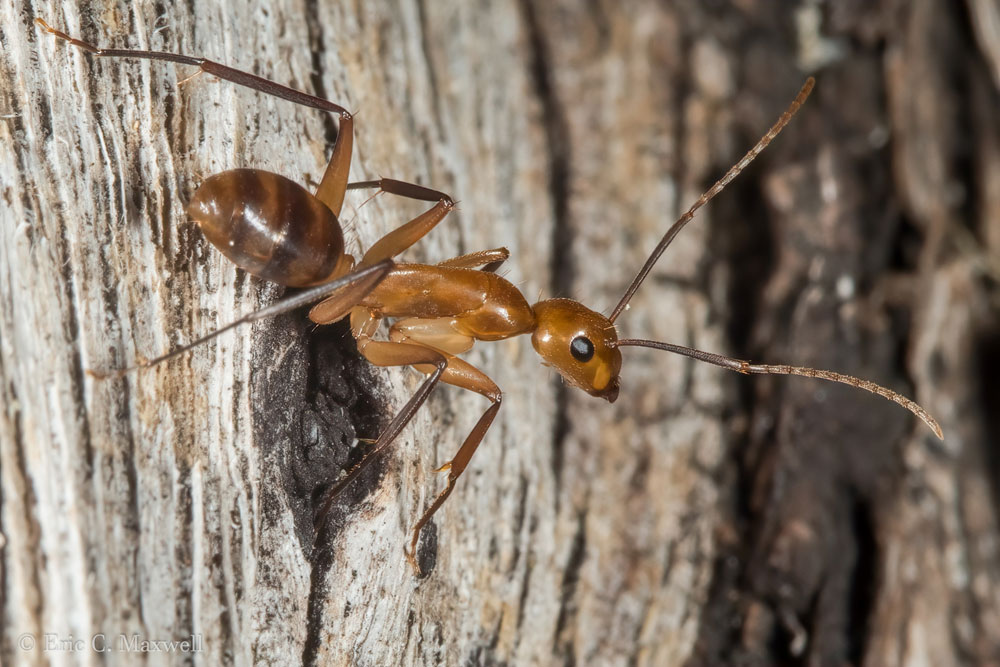
Hawaiian Carpenter Ant
Camponotus variegatus/zonatus

Known from and potential habitat
Species Info General
Other common names include: Large Sugar Ant, Big Brown Ant
Despite their common name, Hawaiian Carpenter Ants are not native to the Islands. This very large ant is usually inconspicuous – until, that is, they decide to move into your house. They tend to be nocturnal: they are commonly seen running about on the ceiling or up and down the walls from dinner time to bed time. When a colony reaches breeding stage, numbers of distressingly large winged queens and males will fly around you as you try to eat your supper. Perkins (1913), wrote that this species “is to a large extent domestic, breeding in incredible numbers in the walls of the wooden houses in Honolulu. In some of these (even in houses only a few years old) this Camponotus . . . is an intolerable nuisance. Swarming takes place on dark still nights, when all forms of the ants issue from their nests, covering the floors, walls and tables and even entering the beds. Though partial to houses, C. maculatus thrives well enough in the open, but only on the lowlands, or at low elevations in the mountains.”
This species in Hawaii has long been referred to as Camponotus variegatus. Recent unpublished genetic work suggests that this ant’s true identity is actually Camponotus zonatus.



Identification/Description
This, Hawaii’s largest ant, is a fast-moving species that “can hardly be overlooked as it is a veritable giant ” (Phillips 1935). “This ant is reddish brown with a transversely dark brown striped abdomen” (Fullaway & Krause 1945). The species is polymorphic, meaning some individuals are quite large, some quite small, while most are somewhere in between. But compared to our other ants, this ant is gigantic. “Large colonies may sometimes stubbornly install themselves in drawers, trunks, and other receptacles. The workers of this active brown ant are almost 7 mm., and the queen about 12 mm. long.” (Williams et al 1931). Fullaway & Krause (1945) noted that this ant tends to have small colonies “consisting of less than a hundred individuals”; however, Tenorio & Nishida (1990) wrote that colonies contain “up to 3,000 workers”. According to Wheeler (1934) it has been found in Hawaii as high as 4000 feet elevation.
Impacts
- “Although dwelling in wood this Camponotus probably does not bore sound timber and so is hardly to be feared” (Williams et al 1931
- Seriously annoying indoor pest at at times
- Attends aphids and mealybugs, so may cause minor problems in the garden
- Observations suggest that its numbers are kept in check by our most common ant, the African Big-headed Ant (Pheidole megacephala). (Williams et al 1931, Phillips 1935, Fullaway & Krause 1945)
History
- This species was on the first annotated list of ants in Hawaii, published in 1879. By that time it was already considered “common in Honolulu” (Blackburn & Kirby 1880), and it likely arrived many decades earlier.
Resources/References
- Maui Invasive Species Committee’s Brief Guide to Maui’s Ants – Camponotus variegatus
- Camponotus variegatus – AntWiki
- Camponotus zonatus – AntWiki
- Blackburn, T. & Kirby, W. F. 1880. Notes on Species of Aculeate Hymenoptera Occurring in
- the Hawaiian Islands. Entomologist’s Monthly Magazine 17: 85-88.
- Fullaway, D. T. & Krause, N. H. L. 1945. Common Insects of Hawaii. Tongg Publishing Co.,
- Honolulu. 228 pp.
- Perkins, R. C. L. 1913. Fauna Hawaiiensis – Introduction. Cambridge University Press,
- London. 1(4): 1–228.
- Phillips, J. S. 1935. The Biology, Distribution and Control of Ants in Hawaiian Pineapple
- Fields. Doctoral Thesis, University of Hawaii. 301 pp.
- Tenorio, J. M. & Nishida, G. M. 1995. What’s Bugging Me? University of Hawaii Press,
- Honolulu. 184 pp.
- Wheeler, W. M. 1934. Revised list of Hawaiian ants. Bishop Museum Occasional Papers
- 10(21): 2–21.
- Williams, F. X., Muir, F., Van Zwaluwenburg, R. H. & Swezey, O.H. 1931. Handbook of The
- Insects and Other Invertebrates of Hawaiian Sugar Cane Fields. Advertiser Publishing Co., Honolulu. 400 pp.
